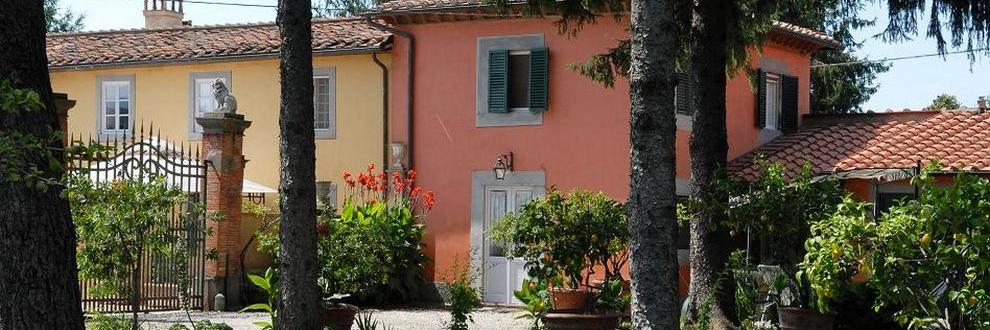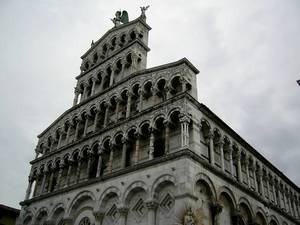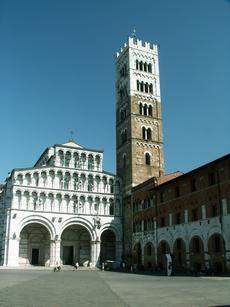
Villa Costa Residenceholiday apartments near Lucca in Tuscany
|
|
Our Accommodations Prices Availability How to find us Places worth visiting Restaurants Practical Tips Houses of Friends Contact Home |
Lucca
Lucca is a unique and charming place full of marvelous monuments. It is easy to fall in love with this city at first sight. The old city center is completely surrounded by an intact 4 km long massive Renaissance wall with 11 bastions and 6 entrance gates, which now serves as a beautiful tree-lined pedestrian promenade – the only such well-preserved wall in Italy. The remains of the even older fortifications are Porta di Borgo and Porta Santi Gervasio e Protasio and part of the old moat running through the city.  Lucca was founded by the Romans about 180 B.C. Its center, the Roman Forum, was situated on the site of the present location of San Michele in Foro. An amphitheater was built outside the Roman walls. It was then fortified and later tenement houses were built into its walls. In 19th century Piazza dell’Anfiteatro emerged in its final unique shape of a quaint round city plaza. Lucca was founded by the Romans about 180 B.C. Its center, the Roman Forum, was situated on the site of the present location of San Michele in Foro. An amphitheater was built outside the Roman walls. It was then fortified and later tenement houses were built into its walls. In 19th century Piazza dell’Anfiteatro emerged in its final unique shape of a quaint round city plaza. Nearby, there is the 12thcentury church of San Frediano with a fantastic colorful mosaic façade depicting Ascension of Christ. Inside, the mummified body of the famous Lucchese Saint Zita is displayed in a transparent casket. San Michele in Foro has an unusually large Renaissance façade ornate with four arcade loggias. Dazzling whiteness of the exterior contrasts sharply with the darkness of the almost windowless interior. On the right side of the altar a painting by Filippin Lippi charms with its beautiful, lively colors.  One of Lucca’s architectural landmarks is Torre Guinigi, a 15th century tower with two oaks growing on its top. The view from the top on the sea of roof tiles, terrace gardens, bell towers and neighboring hills takes your breath away.
One of Lucca’s architectural landmarks is Torre Guinigi, a 15th century tower with two oaks growing on its top. The view from the top on the sea of roof tiles, terrace gardens, bell towers and neighboring hills takes your breath away.San Martino cathedral, finished in the 16th century, has a characteristic asymmetrical façade, built that way to accommodate the pre-existing bell tower. Inside, there are two early Renaissance masterpieces: the Tomb of Ilaria del Carretto by Jacopo Della Quercia of Siena and Volto Santo, almost 3-meter long cedar-wood crucifix and image of Christ which, according to the legend, was carved by his contemporary Nicodemus, and miraculously conveyed to Lucca in 782.  Lucca is the birthplace of a few famous artists, especially Giacomo Puccini, one of Italy’s most famous opera composers (La Boheme, Tosca, Madame Butterfly, etc) and Luigi Boccherini, a classical era composer and cellist. Another 18th century native of Lucca was Pompeo Batoni, a very popular standing portrait painter of the time.
Lucca is the birthplace of a few famous artists, especially Giacomo Puccini, one of Italy’s most famous opera composers (La Boheme, Tosca, Madame Butterfly, etc) and Luigi Boccherini, a classical era composer and cellist. Another 18th century native of Lucca was Pompeo Batoni, a very popular standing portrait painter of the time.Today Lucca boasts not only marvelous architecture, eventful history, medieval churches, beautiful palaces and gardens, but also contributes to the cultural life of modern Italy. Over the last 40 years Lucca has hosted an annual international festival of comics, games, animated films and illustrations, called Lucca Comics and Games. In 2008 on the 150 anniversary of Puccini’s birth Festival Puccini was launched in Lucca. The program will span 3 years and over 1100 musical events. Apart from classical music, every summer, Lucca hosts a summer music festival that draws the biggest names of pop music like Elton John, George Michael, Paco De Lucia and many other great stars. |